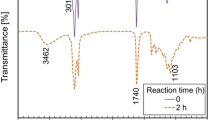Abstract
Due to the great interest in oil-based polymers, which are prepared from renewable resources, different forms and amounts of soybean oil-based PLA films were prepared and evaluated for their potential usage as a medical biomaterial. Soybean oil, epoxidized soybean oil and auto-oxidized soybean oil were blended with PLA and PLA/oil films with appropriate oil amounts [2, 7, 14 and 20% (w/w)] were obtained by solvent casting. Thermal stability and plasticization effect were determined by adjusting oil amounts and type. Epoxidized soybean oil blended films showed the smallest increase in elongation breaks (13–20%) and the highest decrease in thermal decomposition temperatures (364–327 °C) compared to other oil blended films. In vitro quantitative and qualitative cytotoxicity results showed no reactivity (grade 0) for the L929 cells treated with 14% (w/w) oil blended PLA films. In vivo irritation and implantation tests concluded that 14% (w/w) oil blended PLA films were non-irritant. No erythema, no oedema reactions, no traumatic necrosis and foreign debris were observed. Thus, along with superior biocompatibility, PLA/oil films can replace petroleum-based products for several biomedical uses.






Similar content being viewed by others
References
Kaplan DL (1998) Biopolymers from renewable resources. Springer, New York
Meier MAR, Metzger JO, Schubert US (2007) Plant oil renewable resources as green alternatives in polymer science. Chem Soc Rev 36:1788–1802
Guo B, Chen Y, Lei Y, Zhang L, Zhou WY, Rabie ABM, Zhao J (2011) Biobased poly(propylene sebacate) as shape memory polymer with tunable switching temperature for potential biomedical applications. Biomacromolecules 12:1312–1321
Sharma V, Kundu PP (2006) Addition polymers from natural oils—a review. Prog Polym Sci 31:983–1008
Miao S, Wang P, Su Z, Zhang S (2014) Vegetable-oil-based polymers as future polymeric biomaterials. Acta Biomater 10:1692–1704
Lligadas G, Ronda JC, Galia M, Cadiz V (2013) Renewable polymeric materials from vegetable oils: a perspective. Mater Today 16:337–342
Aydın RST, Hazer B, Acar M, Gümüşderelioğlu M (2013) Osteogenic activities of polymeric soybean oil-g-polystyrene membranes. Polym Bull 70:2065–2082
Miao S, Sun L, Wang P, Liu R, Su Z, Zhang S (2012) Soybean oil-based polyurethane networks as candidate biomaterials: synthesis and biocompatibility. Eur J Lipid Sci Technol 114:1165–1174
Hazer DB, Hazer B, Kaymaz F (2009) Synthesis of microbial elastomers based on soybean oily acids. Biocompatibility studies. Biomed Mater 4:035011
Liu Z, Xu Y, Cao L, Bao C, Sun H, Wang L, Daib K, Zhu L (2012) Phosphoester cross-linked vegetable oil to construct a biodegradable and biocompatible elastomer. Soft Matter 8:5888–5895
Lasprilla AJR, Martinez GAR, Jardini AL, Maciel Filho R (2012) Poly-lactic acid synthesis for application in biomedical devices—a review. Biotechnol Adv 30:321–328
Auras R, Harte B, Selke S (2004) An overview of polylactides as packaging materials. Macromol Biosci 4:835–864
Hiljanen-Vainio M, Varpomaa P, Seppala J, Tormala P (1996) Modification of poly(l-lactides) by blending: mechanical and hydrolytic behavior. Macromol Chem Phys 197:1503–1523
Gramlich WM, Robertson ML, Hillmyer MA (2010) Reactive compatibilization of Poly(l-lactide) and conjugated soybean oil. Macromolecules 43:2313–2321
Robertson ML, Chang K, Gramlich WM, Hillmyer MA (2010) Toughening of polylactide with polymerized soybean oil. Macromolecule 43:1807–1814
Chieng WB, İbrahim NA, Then YY, Loo YY (2014) Epoxidized vegetable oils plasticized Poly(lactic acid) biocomposites: mechanical, thermal and morphology properties. Molecules 19:16024–16038
Emad A, Al-Mulla J, Suhail HA, Aowds AS (2011) New biopolymer nanocomposites based on epoxidized soybean oil plasticized poly(lactic acid)/fatty nitrogen compounds modified clay: preparation and characterization. Ind Crops Prod 33:23–29
Fathilah A, Young-Wook C, Shin CK, Joon YY (2009) Thermal, mechanical and rheological properties of poly(lactic acid)/epoxidized soybean oil blends. Polym Bull 62:91–98
Hazer B (2014) The properties of PLA/oxidized soybean oil polymer blends. J Polym Environ 22:200–208
Hazer B, Akyol E (2016) Efficiency of gold nano particles on the autoxidized soybean oil polymer: fractionation and structural analysis. J Am Oil Chem Soc 93:201–213
Çakmakli B, Hazer B, Tekin IO, Cömert FB (2005) Synthesis and characterization of polymeric soybean oil-g-methyl methacrylate (and n-butyl methacrylate) graft copolymers: biocompatibility and bacterial adhesion. Biomacromolecules 6:1750–1758
Kiss E, Bertoti I, Vargha-Butler EI (2002) XPS and wettability characterization of modified Poly(lactic acid) and Poly(lactic/glycolic acid) films. J Colloid Interface Sci 245:91–98
Darie-Nit RN, Vasile C, Irimia A, Lips R, Rapa M (2016) Evaluation of some eco-friendly plasticizers for PLA films processing. J Appl Polym Sci 133:43223(1-11)
Acknowledgements
This study was financially supported by the Turkish Scientific Research Council (Grant Number: 213M375) and Bülent Ecevit University Research Fund (Grant Number: 2014-39971044-02). Authors thank TÜBİTAK-MAM for performing animal experiments (Implantation and Irritation tests).
Author information
Authors and Affiliations
Corresponding author
About this article
Cite this article
Aydın, R.S.T., Akyol, E. & Hazer, B. Influence of Soybean Oil Blending with Polylactic Acid (PLA) Films: In Vitro and In Vivo Evaluation. J Am Oil Chem Soc 94, 413–424 (2017). https://doi.org/10.1007/s11746-017-2954-6
Received:
Revised:
Accepted:
Published:
Issue Date:
DOI: https://doi.org/10.1007/s11746-017-2954-6




